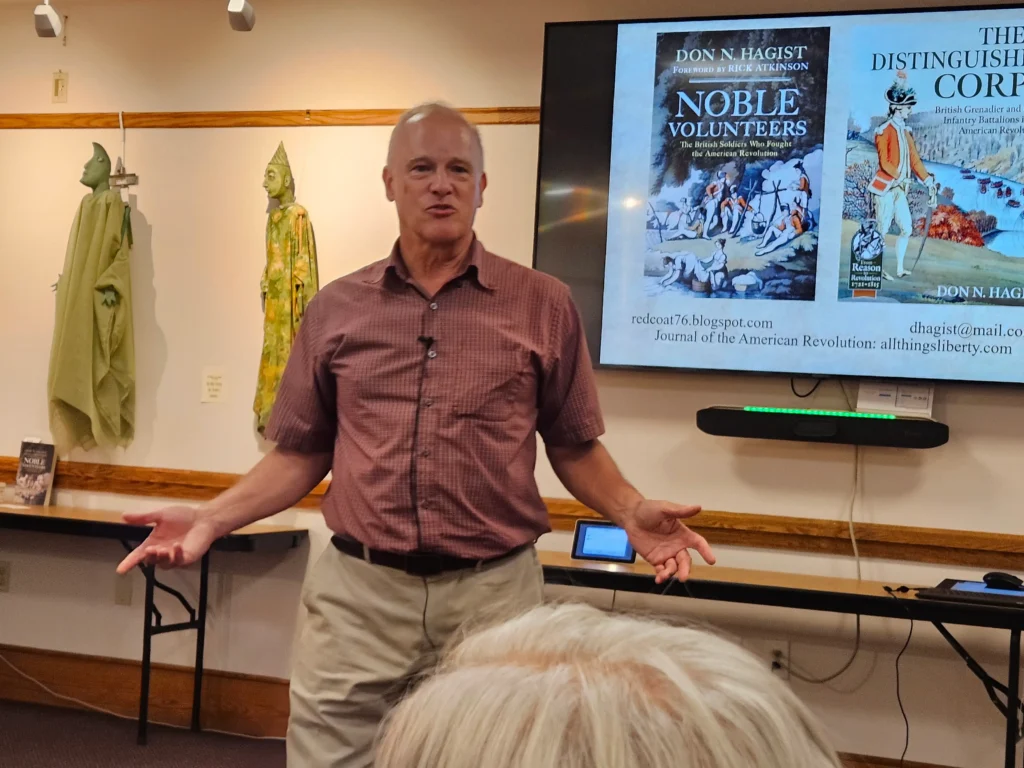As the Acton 250 Lecture Series continues its commemorative journey through the events of April 19, 1775, the community gathered once again on June 23, 2025 — this time to shift the lens. With the flicker of historic memory still fresh from this year’s Patriots’ Day celebrations, the lecture hall welcomed author and historian Don Hagist for an illuminating presentation: “The British Soldiers of April 19th, 1775.”

But rather than recount the familiar valor of local militiamen or the emotional gravity of Isaac Davis’s final march, Hagist asked the audience to consider the men on the other side of the battlefield — not as faceless redcoats, but as complex career soldiers with families, skills, wounds, and worries of their own.
A longtime student of the British Army in the American Revolution and the managing editor of the Journal of the American Revolution, Hagist offered Acton residents a rare and nuanced perspective: who exactly were the British soldiers who marched out of Boston toward Concord on that fateful spring morning?
Redcoats with needle and loom
“Samuel Lee,” Hagist began, “was born in London in 1745. He was a master tailor.” By 1775, Lee had lived and worked in Philadelphia, New Jersey, and New York, settling in Massachusetts just months before the war’s outbreak. He sounded like a typical colonial tradesman — until Hagist revealed Lee was actually a private in the 18th Regiment of Foot, a Grenadier, and among those sent to seize arms in Concord on April 19.
In story after story, Hagist humanized the British soldiers of that day: John Smith, wounded in the thigh, who served 31 years; John Mosley, wounded at Lexington, Bunker Hill, and Brandywine; Alexander M’Lann, a fifer from Ireland who went on to serve until age 62. Their ranks included weavers, blacksmiths, glovers, shoemakers, and even an engraver — Richard Brunton — who later deserted, became an American, and forged his way into notoriety and prison.
As Hagist explained, these weren’t conscripts or unwilling invaders. Every British soldier stationed in Boston in 1775 had volunteered, many during peacetime. They were career soldiers who had enlisted for decades of service, some traveling across the globe with their regiments. “All of them,” he emphasized, “had chosen this life.”
Families in the garrison
But it wasn’t just soldiers who crossed the Atlantic. One in six British troops in Boston brought wives with them, and some, children too. Hagist introduced the audience to Catherine Rogers, widow of Daniel Rogers, a Grenadier killed on April 19. She stayed with the regiment, later remarried another soldier, and continued to live as part of the military community.
“These women weren’t passive tagalongs,” Hagist said. “They worked as nurses, laundresses, and sutlers [civilian merchants who followed the army and sold them provisions], contributing to the army’s operations.” He pointed out the parallels with modern military families, even citing records of women in British garrisons renting their own apartments and earning wages equal to or greater than their husbands.
A career, not a campaign
Hagist shared research into the soldiers’ ages, trades, and enlistment histories. Of the 700 men who marched on April 19, more than half were between the ages of 25 and 40, and over 90% had six or more years of military experience. Despite popular myths, none were conscripts — and only a small fraction deserted during the war.
Indeed, many soldiers spent decades in service. James Rennison, wounded at Lexington and later besieged at Gibraltar, re-enlisted *three* times after receiving his pension. Others, like Dennis Green, carried musket balls from Concord in their bodies for life.
Still others stayed in North America after the war. Some received land grants in Nova Scotia. A few, like Brunton, defected and assimilated. Hagist noted that of the 458 soldiers whose full wartime trajectories he has uncovered so far, over 199 received pensions — an unusually high proportion reflecting their long and loyal careers.
Reclaiming a lost narrative
Don Hagist’s presentation was not only rich in detail, but also generous in spirit. He wasn’t out to glorify the British side, nor diminish the sacrifices of Acton’s own. Instead, he invited residents to complicate the narrative — to recognize the full humanity on both sides of the musket.
“These men,” Hagist concluded, “weren’t just part of some imperial monolith. They were people, living lives not so different from our own. They were trying to do their jobs, provide for their families, and survive a war that many never expected.”
The Acton 250 Lecture Series, made possible by partnerships between local civic organizations and generously supported by the Acton Lions Club, continues to engage the public in ways that deepen and diversify historical understanding. As part of its mission to highlight underrepresented perspectives, the Acton 250 Committee’s History Subcommittee has struck a chord by inviting voices like Hagist’s — ones that ask us to reexamine the past not in black and white, but in the rich, complex tones of lived experience.
For those interested in more stories of the British soldiers of the Revolution, Hagist’s work is available in print and online at the Journal of the American Revolution.
Greg Jarboe writes on a variety of topics for the Acton Exchange. He is a former editor of the Acton Minuteman and a former chair of the Acton Select Board, and a current member of the Acton Finance Committee, Public Works Facility Committee, and the Economic Development Committee.













